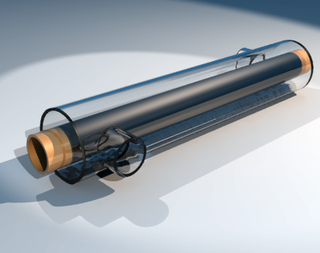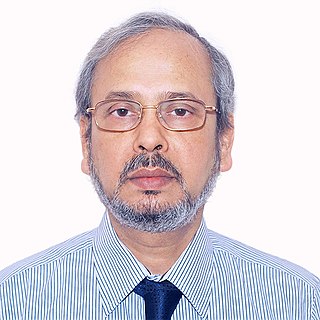Related Research Articles
A discrete element method (DEM), also called a distinct element method, is any of a family of numerical methods for computing the motion and effect of a large number of small particles. Though DEM is very closely related to molecular dynamics, the method is generally distinguished by its inclusion of rotational degrees-of-freedom as well as stateful contact and often complicated geometries. With advances in computing power and numerical algorithms for nearest neighbor sorting, it has become possible to numerically simulate millions of particles on a single processor. Today DEM is becoming widely accepted as an effective method of addressing engineering problems in granular and discontinuous materials, especially in granular flows, powder mechanics, and rock mechanics. DEM has been extended into the Extended Discrete Element Method taking heat transfer, chemical reaction and coupling to CFD and FEM into account.

A heat exchanger is a system used to transfer heat between a source and a working fluid. Heat exchangers are used in both cooling and heating processes. The fluids may be separated by a solid wall to prevent mixing or they may be in direct contact. They are widely used in space heating, refrigeration, air conditioning, power stations, chemical plants, petrochemical plants, petroleum refineries, natural-gas processing, and sewage treatment. The classic example of a heat exchanger is found in an internal combustion engine in which a circulating fluid known as engine coolant flows through radiator coils and air flows past the coils, which cools the coolant and heats the incoming air. Another example is the heat sink, which is a passive heat exchanger that transfers the heat generated by an electronic or a mechanical device to a fluid medium, often air or a liquid coolant.

Heat transfer is a discipline of thermal engineering that concerns the generation, use, conversion, and exchange of thermal energy (heat) between physical systems. Heat transfer is classified into various mechanisms, such as thermal conduction, thermal convection, thermal radiation, and transfer of energy by phase changes. Engineers also consider the transfer of mass of differing chemical species, either cold or hot, to achieve heat transfer. While these mechanisms have distinct characteristics, they often occur simultaneously in the same system.
In fluid dynamics, the Schmidt number of a fluid is a dimensionless number defined as the ratio of momentum diffusivity and mass diffusivity, and it is used to characterize fluid flows in which there are simultaneous momentum and mass diffusion convection processes. It was named after German engineer Ernst Heinrich Wilhelm Schmidt (1892–1975).

In fluid mechanics, multiphase flow is the simultaneous flow of materials with two or more thermodynamic phases. Virtually all processing technologies from cavitating pumps and turbines to paper-making and the construction of plastics involve some form of multiphase flow. It is also prevalent in many natural phenomena.

Fluid–structure interaction (FSI) is the interaction of some movable or deformable structure with an internal or surrounding fluid flow. Fluid–structure interactions can be stable or oscillatory. In oscillatory interactions, the strain induced in the solid structure causes it to move such that the source of strain is reduced, and the structure returns to its former state only for the process to repeat.
Micro heat exchangers,Micro-scale heat exchangers, or microstructured heat exchangers are heat exchangers in which fluid flows in lateral confinements with typical dimensions below 1 mm. The most typical such confinement are microchannels, which are channels with a hydraulic diameter below 1 mm. Microchannel heat exchangers can be made from metal or ceramic.
Yuwen Zhang is an American professor of mechanical engineering who is well known for his contributions to phase change heat transfer. He is presently a Curators' Distinguished Professor and Huber and Helen Croft Chair in Engineering in the Department of Mechanical and Aerospace Engineering at the University of Missouri in Columbia, Missouri.

The viscosity of a fluid is a measure of its resistance to deformation at a given rate. For liquids, it corresponds to the informal concept of "thickness": for example, syrup has a higher viscosity than water. Viscosity is defined scientifically as a force multiplied by a time divided by an area. Thus its SI units are newton-seconds per square metre, or pascal-seconds.

A liquid is a nearly incompressible fluid that conforms to the shape of its container but retains a nearly constant volume independent of pressure. It is one of the four fundamental states of matter, and is the only state with a definite volume but no fixed shape.
The moving particle semi-implicit (MPS) method is a computational method for the simulation of incompressible free surface flows. It is a macroscopic, deterministic particle method developed by Koshizuka and Oka (1996).
A nanofluid is a fluid containing nanometer-sized particles, called nanoparticles. These fluids are engineered colloidal suspensions of nanoparticles in a base fluid. The nanoparticles used in nanofluids are typically made of metals, oxides, carbides, or carbon nanotubes. Common base fluids include water, ethylene glycol and oil.
In engineering, physics, and chemistry, the study of transport phenomena concerns the exchange of mass, energy, charge, momentum and angular momentum between observed and studied systems. While it draws from fields as diverse as continuum mechanics and thermodynamics, it places a heavy emphasis on the commonalities between the topics covered. Mass, momentum, and heat transport all share a very similar mathematical framework, and the parallels between them are exploited in the study of transport phenomena to draw deep mathematical connections that often provide very useful tools in the analysis of one field that are directly derived from the others.

A bubble column reactor is a chemical reactor that belongs to the general class of multiphase reactors, which consists of three main categories: trickle bed reactor, fluidized bed reactor, and bubble column reactor. A bubble column reactor is a very simple device consisting of a vertical vessel filled with water with a gas distributor at the inlet. Due to the ease of design and operation, which does not involve moving parts, they are widely used in the chemical, biochemical, petrochemical, and pharmaceutical industries to generate and control gas-liquid chemical reactions.
In queueing theory, a discipline within the mathematical theory of probability, a fluid queue is a mathematical model used to describe the fluid level in a reservoir subject to randomly determined periods of filling and emptying. The term dam theory was used in earlier literature for these models. The model has been used to approximate discrete models, model the spread of wildfires, in ruin theory and to model high speed data networks. The model applies the leaky bucket algorithm to a stochastic source.

Dimitris Drikakis, PhD, FRAeS, CEng, is a Greek-British applied scientist, engineer and university professor. His research is multidisciplinary. It covers fluid dynamics, computational fluid dynamics, acoustics, heat transfer, computational science from molecular to macro scale, materials, machine learning, and emerging technologies. He has applied his research to diverse fields such as Aerospace & Defence, Biomedical, and Energy and Environment Sectors. He received The William Penney Fellowship Award by the Atomic Weapons Establishment to recognise his contributions to compressible fluid dynamics. He was also the winner of NEF's Innovator of the Year Award by the UK's Institute of Innovation and Knowledge Exchange for a new generation carbon capture nanotechnology that uses carbon nanotubes for filtering out carbon dioxide and other gases.
The contemporary conjugate convective heat transfer model was developed after computers came into wide use in order to substitute the empirical relation of proportionality of heat flux to temperature difference with heat transfer coefficient which was the only tool in theoretical heat convection since the times of Newton. This model, based on a strictly mathematically stated problem, describes the heat transfer between a body and a fluid flowing over or inside it as a result of the interaction of two objects. The physical processes and solutions of the governing equations are considered separately for each object in two subdomains. Matching conditions for these solutions at the interface provide the distributions of temperature and heat flux along the body–flow interface, eliminating the need for a heat transfer coefficient. Moreover, it may be calculated using these data.

Non ideal compressible fluid dynamics (NICFD), or non ideal gas dynamics, is a branch of fluid mechanics studying the dynamic behavior of fluids not obeying ideal-gas thermodynamics. It is for example the case of dense vapors, supercritical flows and compressible two-phase flows. With the term dense vapors, we indicate all fluids in the gaseous state characterized by thermodynamic conditions close to saturation and the critical point. Supercritical fluids feature instead values of pressure and temperature larger than their critical values, whereas two-phase flows are characterized by the simultaneous presence of both liquid and gas phases.

Gautam Biswas is presently a professor of mechanical engineering at the Indian Institute of Technology (IIT) Kanpur. Earlier, he has been the director of Indian Institute of Technology Guwahati, and director of the CSIR - Central Mechanical Engineering Research Institute at Durgapur. As a faculty member of IIT Kanpur, he has served the Institute in various capacities including the Dean of Academic Affairs. Prof Gautam Biswas is a Fellow of the three science academies, such as, the Indian National Science Academy, the Indian Academy of Sciences and the National Academy of Sciences India. He is a Fellow of the Indian National Academy of Engineering (INAE) and Institution of Engineers (IEI). He was the occupant of the position of GD and VM Mehta Endowed Chair Professor of Mechanical Engineering at the Indian Institute of Technology Kanpur. A Fellow of the American Society of Mechanical Engineers (ASME), Prof Biswas is the author of more than 150 scientific publications and guided 23 PhD theses. In the year 2011, he was awarded the esteemed J C Bose National Fellowship by the Science and Engineering Research Board (DST), Government of India. Biswas completed his B.E. from IIEST(Erstwhile B.E. College under Calcutta University) in 1979. He completed his PhD from the Indian Institute of Technology Kharagpur in 1985. He was an Alexander von Humboldt Fellow at the Ruhr University Bochum in Germany and JSPS Invitation Fellow at the Yokohama National University, Japan. He has been a guest professor at the Friedrich-Alexander-Universität Erlangen-Nürnberg, Germany. Prof. Biswas was awarded an honorary doctorate by the National Institute of Technology Agartala in 2017. He has been conferred honorary doctorate by the Aristotle University of Thessaloniki, Greece, in 2018. In recognition of his stellar contribution in the fields of Fluid Mechanics and Thermal Sciences, his contributions as an academic administrator and his dedicated service to the institute, IIT Kanpur bestowed upon Professor Gautam Biswas the award of Institute Fellow for the year 2020. In recognition of his outstanding contribution to teaching, IIT Kanpur conferred the Distinguished Teacher Award upon Professor Gautam Biswas in the year 2022. Prof. Biswas has been selected for 2023 ASME Heat Transfer Memorial Award in the Science Category for Sustained and Outstanding Contributions to Thermal Science and Engineering, including Heat Transfer Enhancement, Phase Change Heat Transfer with and without Electrohydrodynamic Forces and Dynamics of Liquid Jet and Droplet Impingement.
Pillow-plate heat exchangers are a class of fully welded heat exchanger design, which exhibit a wavy, “pillow-shaped” surface formed by an inflation process. Compared to more conventional equipment, such as shell and tube and plate and frame heat exchangers, pillow plates are a quite young technology. Due to their geometric flexibility, they are used as well as “plate-type” heat exchangers and as jackets for cooling or heating of vessels. Pillow plate equipment is currently experiencing increased attention and implementation in process industry.
References
- 1 2 3 "Russell Keanini | Mechanical Engineering and Engineering Science | UNC Charlotte". mees.charlotte.edu.
- 1 2 "Kirk Bryan Award – Quaternary Geology & Geomorphology Division". community.geosociety.org.
- ↑ "Lecture notes: Advanced Fluid Mechanics | Russ Keanini".
- ↑ Keanini, Russell Guy (1992). Numerical and analytical studies of phase change processes (Thesis). OCLC 892822306. ProQuest 304052729.[ non-primary source needed ]
- ↑ Johnson, R.E.; Keanini, R.G. (March 1998). "An asymptotic model of work roll heat transfer in strip rolling". International Journal of Heat and Mass Transfer. 41 (6–7): 871–879. doi:10.1016/S0017-9310(97)00175-0.[ non-primary source needed ]
- ↑ Keanini, Russell G. (January 1998). "Inverse estimation of surface heat flux distributions during high speed rolling using remote thermal measurements". International Journal of Heat and Mass Transfer. 41 (2): 275–285. doi:10.1016/S0017-9310(97)00144-0.[ non-primary source needed ]
- ↑ Keanini, Russell G.; Roer, Robert D.; Dillaman, Richard M. (August 1995). "A theoretical model of circulatory interstitial fluid flow and species transport within porous cortical bone". Journal of Biomechanics. 28 (8): 901–914. doi:10.1016/0021-9290(94)00157-Y. PMID 7673258.[ non-primary source needed ]
- ↑ Lawton, Kevin M.; Patterson, Steven R.; Keanini, Russell G. (1 May 2003). "Direct contact packed bed thermal gradient attenuators: Theoretical analysis and experimental observations". Review of Scientific Instruments. 74 (5): 2886–2893. Bibcode:2003RScI...74.2886L. doi:10.1063/1.1564279.[ non-primary source needed ]
- 1 2 Fleischhauer, E.; Azimi, F.; Tkacik, P.; Keanini, R.; Mullany, B. (March 2016). "Application of particle image velocimetry (PIV) to vibrational finishing". Journal of Materials Processing Technology. 229: 322–328. doi:10.1016/j.jmatprotec.2015.09.017.[ non-primary source needed ]
- ↑ Keanini, Russell G.; Dahlberg, Jerry; Tkacik, Peter T. (28 January 2021). "On the physical mechanisms underlying single molecule dynamics in simple liquids". Scientific Reports. 11 (1): 2528. doi:10.1038/s41598-021-82112-8. PMC 7843658 . PMID 33510369.[ non-primary source needed ]
- ↑ "Molecular hopping in solid-like liquids: Understanding the self-diffusion and viscosity of liquid molecules". 3 September 2021.
- ↑ Keanini, Russell G.; Dahlberg, Jerry; Brown, Philip; Morovati, Mehdi; Moradi, Hamidreza; Jacobs, Donald; Tkacik, Peter T. (November 2023). "Stochastic estimation of Green's functions with application to diffusion and advection-diffusion-reaction problems". Applied Mathematics and Computation. 457: 128186. arXiv: 2206.02521 . doi:10.1016/j.amc.2023.128186.[ non-primary source needed ]
- ↑ Keanini, R.G (8 February 2007). "Random walk methods for scalar transport problems subject to Dirichlet, Neumann and mixed boundary conditions". Proceedings of the Royal Society A: Mathematical, Physical and Engineering Sciences. 463 (2078): 435–460. Bibcode:2007RSPSA.463..435K. doi:10.1098/rspa.2006.1769. S2CID 2265032.[ non-primary source needed ]
- ↑ Keanini, R.G. (April 2011). "Green's function-stochastic methods framework for probing nonlinear evolution problems: Burger's equation, the nonlinear Schrödinger's equation, and hydrodynamic organization of near-molecular-scale vorticity". Annals of Physics. 326 (4): 1002–1031. arXiv: 1007.2125 . Bibcode:2011AnPhy.326.1002K. doi:10.1016/j.aop.2010.12.004. S2CID 119658044.[ non-primary source needed ]
- ↑ Keanini, R. G.; Tkacik, Peter T.; Fleischhauer, Eric; Shahinian, Hossein; Sholar, Jodie; Azimi, Farzad; Mullany, Brid (31 January 2017). "Macroscopic liquid-state molecular hydrodynamics". Scientific Reports. 7 (1): 41658. Bibcode:2017NatSR...741658K. doi:10.1038/srep41658. PMC 5282555 . PMID 28139711.[ non-primary source needed ]
- ↑ Mullany, B.; Shahinian, H.; Navare, J.; Azimi, F.; Fleischhauer, E.; Tkacik, P.; Keanini, R. (2017). "The application of computational fluid dynamics to vibratory finishing processes". CIRP Annals. 66 (1): 309–312. doi: 10.1016/j.cirp.2017.04.087 .[ non-primary source needed ]
- ↑ Fleischhauer, Eric; Dahlberg, Jerry L; Solomon, Jason M; Keanini, Russell G; Tkacik, Peter T (1 May 2019). "Kinematic viscosity measurement of granular flows via low Reynolds number cylinder drag experiment". Measurement Science and Technology. 30 (5): 055904. Bibcode:2019MeScT..30e5904F. doi:10.1088/1361-6501/ab08cf. S2CID 128337952.[ non-primary source needed ]
- ↑ Eppes, Martha Cary; Aldred, Jennifer; Berberich, Samantha; Dahlquist, Maxwell P.; Evans, Sarah G.; Keanini, Russell; Moser, Faye; Morovati, Mehdi; Porson, Steven; Rasmussen, Monica; Rinehart, Alex; Shaanan, Uri (12 December 2022). "Standardized field methods for fracture-focused surface processes research". doi: 10.5194/esurf-2022-61 .
{{cite journal}}: Cite journal requires|journal=(help)[ non-primary source needed ] - ↑ Eppes, Martha-Cary; Heap, Mike; Baud, Patrick; Bonami, Thomas; Dahlquist, Max; Keanini, Russell; LaCroix, Cyril; Rasmussen, Monica; Rinehart, Alex; El Alaoui, Youness; Windenberger, Adrien (15 May 2023). "Testing natural fracture growth-fracturing resilience feedbacks in rock". Egu General Assembly Conference Abstracts. Bibcode:2023EGUGA..25.5158E. doi: 10.5194/egusphere-egu23-5158 .[ non-primary source needed ]
- ↑ Keanini, Russell G. (July 1994). "Thermocapillary, buoyancy and shear-driven flow within thin annular fluid collars". International Journal of Heat and Mass Transfer. 37 (11): 1579–1591. doi:10.1016/0017-9310(94)90174-0.[ non-primary source needed ]
- ↑ "Linear and nonlinear waves on coating entrance menisci Abstract" (PDF).[ full citation needed ][ non-primary source needed ]
- ↑ Keanini, R. G.; Nortey, T. D.; Thorsett-Hill, Karen; Srivastava, N.; Hellman, Sam; Tkacik, P. T.; Knight, P. Douglas (2011). "Shock-Induced Turbulent Boundary Layer Separation in Over-Expanded Rocket Nozzles: Physics, Models, Random Side Loads, and the Diffusive Character of Stochastic Rocket Ascent". Mass Transfer – Advanced Aspects. doi:10.5772/22597. ISBN 978-953-307-636-2. S2CID 51857619.[ non-primary source needed ][ predatory publisher ]
- ↑ Keanini, R. G.; Rubinsky, B. (1 November 1992). "Optimization of Multiprobe Cryosurgery". Journal of Heat Transfer. 114 (4): 796–801. doi:10.1115/1.2911885.[ non-primary source needed ]